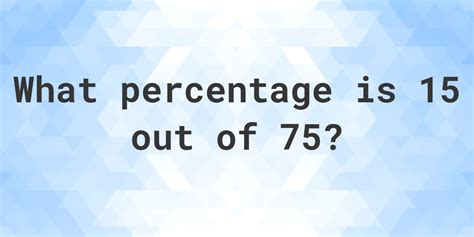What Percentage Is 15 Of 75
Kalali
Mar 29, 2025 · 4 min read

Table of Contents
What Percentage is 15 of 75? A Deep Dive into Percentage Calculations
Determining what percentage 15 represents of 75 might seem like a simple arithmetic problem, but understanding the underlying concepts and various methods for solving it provides a strong foundation for tackling more complex percentage calculations. This comprehensive guide will explore different approaches to solving this problem, delve into the practical applications of percentage calculations, and offer tips and tricks for mastering percentage-related tasks.
Understanding Percentages: The Fundamentals
Before diving into the solution, let's solidify our understanding of percentages. A percentage is a fraction or ratio expressed as a number out of 100. The symbol "%" represents "per cent," meaning "out of one hundred." For example, 50% means 50 out of 100, or 50/100, which simplifies to 1/2.
Method 1: Using the Basic Percentage Formula
The most straightforward method to determine what percentage 15 is of 75 is using the fundamental percentage formula:
(Part / Whole) x 100% = Percentage
In this case:
- Part: 15 (the value we want to express as a percentage)
- Whole: 75 (the total value)
Substituting these values into the formula:
(15 / 75) x 100% = 20%
Therefore, 15 is 20% of 75.
Understanding the Calculation: A Step-by-Step Breakdown
-
The Fraction: The first step involves expressing the relationship between the part (15) and the whole (75) as a fraction: 15/75.
-
Simplifying the Fraction: To simplify this fraction, we find the greatest common divisor (GCD) of 15 and 75, which is 15. Dividing both the numerator and the denominator by 15 gives us 1/5.
-
Converting to Percentage: To convert the fraction 1/5 to a percentage, we multiply it by 100%: (1/5) x 100% = 20%.
Method 2: Using Decimal Equivalents
Another approach involves converting the fraction to a decimal before multiplying by 100%.
-
Fraction to Decimal: Divide the part (15) by the whole (75): 15 ÷ 75 = 0.2
-
Decimal to Percentage: Multiply the decimal (0.2) by 100%: 0.2 x 100% = 20%
This method provides an alternative way to arrive at the same answer: 20%.
Method 3: Cross-Multiplication (Proportion Method)
This method uses proportions to solve the problem. We set up a proportion:
15/75 = x/100
Where 'x' represents the unknown percentage. To solve for x, we cross-multiply:
15 x 100 = 75 x x
1500 = 75x
x = 1500 / 75
x = 20
Therefore, x = 20%, confirming our previous results.
Real-World Applications of Percentage Calculations
Understanding percentage calculations is crucial in numerous real-world scenarios:
-
Finance: Calculating interest rates, discounts, tax rates, profit margins, and investment returns all rely heavily on percentage calculations.
-
Retail: Determining sale prices, calculating markups, and understanding profit percentages are essential for businesses.
-
Science: Expressing experimental results, analyzing data, and calculating statistical measures often involve percentages.
-
Everyday Life: Calculating tips, understanding discounts, and interpreting statistics presented as percentages are common everyday tasks.
Advanced Percentage Calculations: Beyond the Basics
While the problem of finding what percentage 15 is of 75 is relatively simple, let's explore more complex percentage scenarios that build upon the fundamental principles:
1. Finding the Percentage Increase or Decrease:
Calculating percentage change is vital in various contexts, like tracking stock prices or analyzing population growth. The formula is:
[(New Value - Old Value) / Old Value] x 100%
For example, if a stock price increases from $50 to $60, the percentage increase is:
[(60 - 50) / 50] x 100% = 20%
2. Calculating the Whole When the Percentage and Part are Known:
Suppose you know that 20% of a number is 15. To find the original number (the whole), you can use the formula:
(Part / Percentage) x 100 = Whole
In this case:
(15 / 20) x 100 = 75
3. Finding the Part When the Percentage and Whole are Known:
If you know that 20% of 75 is needed, you can calculate the part using:
(Percentage / 100) x Whole = Part
(20 / 100) x 75 = 15
Tips and Tricks for Mastering Percentage Calculations:
-
Practice Regularly: The key to mastering percentages is consistent practice. Solve various problems to build your understanding and speed.
-
Use a Calculator: For more complex calculations, a calculator can significantly speed up the process.
-
Understand the Concepts: Don't just memorize formulas; understand the underlying principles. This will help you apply the concepts to different scenarios.
-
Break Down Complex Problems: If faced with a challenging problem, break it down into smaller, manageable steps.
-
Check Your Answers: Always double-check your answers using a different method to ensure accuracy.
Conclusion:
Determining what percentage 15 represents of 75, while seemingly simple, provides a valuable foundation for understanding and applying percentage calculations in various contexts. By mastering the fundamental formulas and employing different calculation methods, you'll be well-equipped to handle a wide range of percentage-related problems, both in your academic pursuits and everyday life. The ability to confidently and accurately calculate percentages is a valuable skill that enhances problem-solving abilities across numerous disciplines. Remember to practice regularly and to understand the underlying concepts to fully grasp the power and application of percentages.
Latest Posts
Latest Posts
-
18 Cm Equals How Many Inches
Apr 01, 2025
-
How Much Is 70 Ounces Of Water
Apr 01, 2025
-
Cuanto Es 56 Grados Fahrenheit En Centigrados
Apr 01, 2025
-
115 Out Of 125 As A Percentage
Apr 01, 2025
-
What Is 10 5 Inches In Cm
Apr 01, 2025
Related Post
Thank you for visiting our website which covers about What Percentage Is 15 Of 75 . We hope the information provided has been useful to you. Feel free to contact us if you have any questions or need further assistance. See you next time and don't miss to bookmark.
